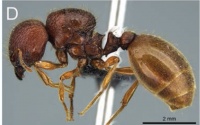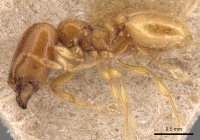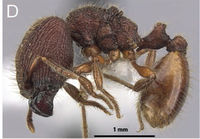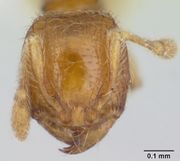Key to Carebara polita species group workers
This worker key is based on: Fischer, G., Azorsa, F. & Fisher, B.L. 2014. The ant genus Carebara Westwood (Hymenoptera, Formicidae): synonymisation of Pheidologeton Mayr under Carebara, establishment and revision of the C. polita species group. ZooKeys 438:57–112. doi:10.3897/zookeys.438.7922
You may also be interested in
This is a combined key for major and minor workers, but note that majors of C. brevipilosa and C. villiersi are unknown.
1
- Antennae with 11 segments. Major workers (where known): Head of major in full-face view either with subparallel sides or posterior wider than anterior (Fig. 3A). Minor workers: Either frontal carinae extending to about cephalic midlength or less (Fig. 3B), or if longer, then dorsum of promesonotum at least partly with sculpture . . . . . 2
- Antennae with 9 segments. Major workers: Head anterior significantly wider than posterior (Fig. 3C). Minor workers: Frontal carinae extending to about 3/4 of the length of the head (Fig. 3D) and dorsum of promesonotum smooth and shiny. (Central African Republic, Dem. Rep. Congo, Gabon, Uganda) . . . . . Carebara madibai
 Carebara madibai, Major |
2
return to couplet #1
- Major workers: Head posterior wider than anterior, in full-face view weakly heart-shaped or with angulate posterolateral corners (Fig. 4A). Minor workers: Head entirely smooth and shiny and oval, with convex to strongly convex sides and rounded posterior corners (Fig. 4B) . . . . . 3
- Major workers: Head posterior about as wide as anterior, with subparallel sides and rounded posterolateral corners (Fig. 4C). Minor workers: Head either not entirely smooth and shiny, or subrectangular with weakly convex sides, or both (Fig. 4D) . . . . . 5
3
return to couplet #2
- Major workers: Head and body very large and massive (HW 1.20–2.09, PNH 0.83–1.48), head posterior wider than anterior with convex sides and widely concave to shallowly V-shaped posterior emargination (Fig. 5A, B). Minor workers: Head oval with strongly convex sides, posterior head margin deeply concave in full-face view, frontal carinae moderately long, reaching to about cephalic midlength or slightly beyond (Fig. 5C) . . . . . 4
- Major workers: unknown. Minor workers: Head shape rounded with strongly convex sides, with posterior head margin straight to faintly convex medially, frontal carinae very short to inconspicuous (Fig. 5D), spines very long, in dorsal view distinctly longer than space between them. (Cameroon, Central African Republic, Gabon, Ghana, Guinea, Ivory Coast) . . . . . Carebara villiersi
 Carebara villiersi Minor |
4
return to couplet #3
- Major workers: Head posterior with small protuberances or horns at posterolateral lobes, scutum in profile dorsally straight or only faintly convex (Fig. 6A), petiolar anteroventral process shallowly developed, pubescence and standing hairs on gaster rather rare. Minor workers: Mesonotum and propodeum in profile mostly smooth and shiny (Fig. 6B). (Cameroon, Central African Republic, Gabon, Kenya, Tanzania, Uganda) . . . . . Carebara polita
- Major workers: Head without horns at posterolateral lobes, scutum in profile dorsally strongly convex (Fig. 6C), petiolar anteroventral process well-defined, finger-like, pointing anteriorly, pubescence and standing hairs on gaster very abundant. Minor workers: Mesonotum and propodeum in profile areolate (Fig. 6D). (Zambia, Zimbabwe) . . . . . Carebara nicotianae
 Carebara nicotianae, Major |
5
return to couplet #2
- Major workers: Head distinctly longer than wide in full-face view (CI 71–87) (Fig. 7A). Posterior head margin with transverse carina. Minor workers: Anteroventral face of petiole straight or weakly concave and subpetiolar process absent (Fig. 7B). (Afrotropics) . . . . . 6
- Major workers (C. urichi only): Head about as long as wide to slightly longer (CI 92–99) (Fig. 7C). Posterior head margin lacking transverse carina. Minor workers: Subpetiolar process present (Fig. 7D). (Neotropics) . . . . . 7
6
return to couplet #5
- Smaller species (HW major worker: 0.52–0.70). Major workers: Lateropronotum and anepisternum smooth and shiny, katepisternum and lateropropodeum weakly to superficially areolate (Fig. 8A). Postpetiole relatively wide, compared to pronotal width (PPI 60–66) and postpetiole length (DPpI 100–128). Minor workers: Cephalic dorsum and pronotum smooth and shiny, head shape subrectangular with weakly convex sides (Fig. 8B). (Kenya, Rwanda, South Africa, Tanzania, Uganda, Zambia, Zimbabwe) . . . . . Carebara perpusilla
 Carebara perpusilla, Major |
- Slightly larger species (HW major worker: 0.64–0.99). Major workers: Lateropronotum, anepisternum, katepisternum, and lateropropodeum usually densely areolate (Fig. 8C). Postpetiole relatively narrower, compared to pronotal width (PPI 45–52) and postpetiole length (DPpI 132–167). Minor workers: Frons often smooth and shiny, remainder of cephalic dorsum usually coarsely rugoreticulate, pronotum never completely smooth, usually with some areolate or rugose sculpture present, head shape suboval with strongly convex sides (Fig. 8D). (Cameroon, Central African Republic, Equatorial Guinea, Gabon, Ghana, Ivory Coast, Kenya, Uganda, Zimbabwe) . . . . . Carebara silvestrii
 Carebara silvestrii, Major |
7
return to couplet #5
- Major workers: unknown. Minor workers: Sculpture on dorsal promesonotum weakly to superficially reticulate with or without very few short rugulae (Fig. 9A), metatibiae with short, appressed to decumbent pilosity (Fig. 9B). (Brazil, Colombia, Costa Rica, Panama) . . . . . Carebara brevipilosa
 Carebara brevipilosa Minor |
- Major workers: Head with strongly raised rugae anteriorly and rugoreticulation posteriorly (C), metatibiae with subdecumbent pilosity and with long suberect hairs along outer edge. Minor workers: Sculpture on dorsal promesonotum irregularly longitudinally rugose to rugoreticulate with few irregular longitudinal rugae (Fig. 9D), metatibiae with subdecumbent pilosity and additionally with long suberect hairs (Fig. 9E). (Belize, Brazil, Colombia, Costa Rica, Mexico, Panama, Peru, Surinam, Trinidad) . . . . . Carebara urichi
 Carebara urichi, Major |



















